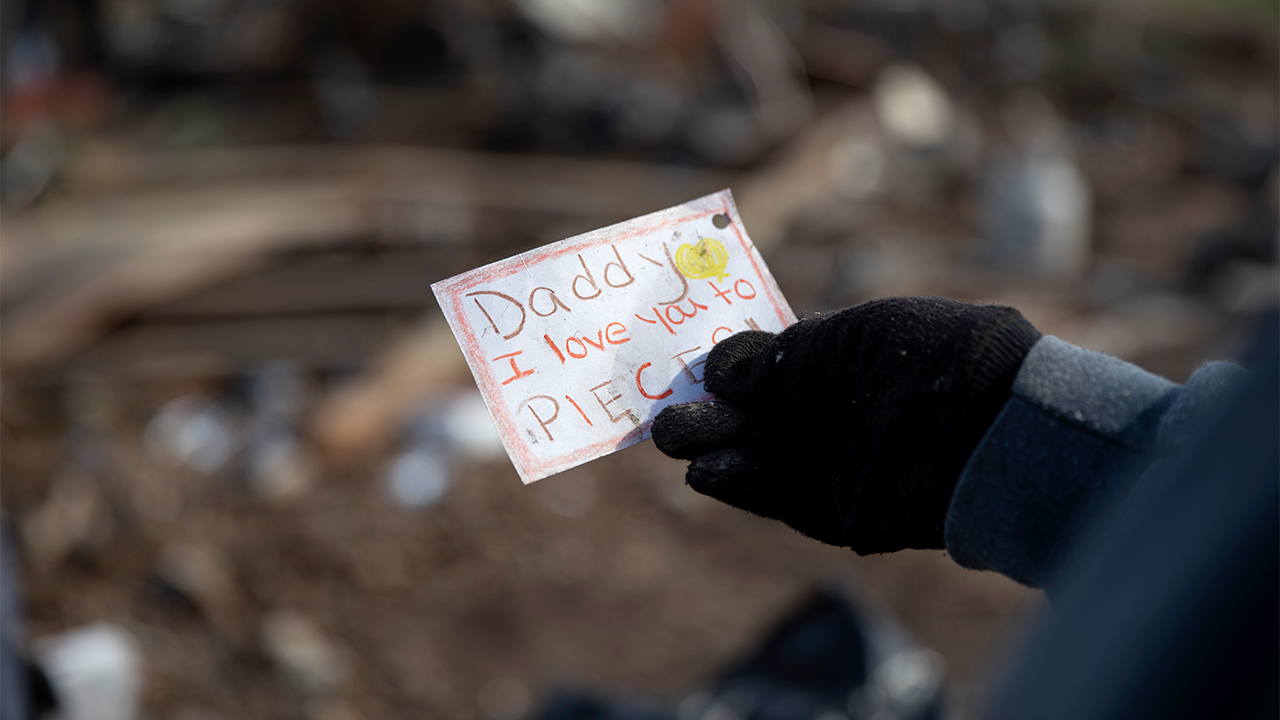BEAUREGARD, Ala. (AP) — Picking through the twisted debris that had been her Alabama mobile home, Carol Dean found her wedding dress and a Father’s Day note to her husband reading, “Daddy, I love you to pieces.”
Her husband was “done and gone,” she said, one of 23 victims of what one National Weather Service meteorologist called a “monster tornado.”

She was on the clock Sunday afternoon at Walmart while her husband, David Wayne Dean, was home in Beauregard. He had heard the forecasts warning that stormy weather was heading toward their rural community. He sent a text message cautioning a friend to pay attention to the news.
Then the storm hit. Dean, 53, didn’t make it to safety. His body was found on the other side of an embankment in the neighbor’s yard.
“Our son found him,” Dean said between sobs Monday. “He was done and gone before we got to him. My life is gone. He was the reason I lived, the reason that I got up.”

The tornado packed winds estimated at 170 mph and chewed a path of destruction up to nine-tenths of a mile wide in Alabama for nearly 27 miles, the weather service said Tuesday after its crews surveyed the impact. The weather service said 90 people were injured.
The twister was part of a powerful storm system that slashed its way across the Deep South, spawning numerous tornado warnings. Government teams surveying storm damage confirmed Tuesday that at least 18 tornadoes struck on Sunday in Alabama, Florida, Georgia and South Carolina alone.
Mobile homes tucked among tall pine trees were swept from their bases and smashed into unrecognizable piles of rubble. Toys, clothes, insulation, water heaters and pieces of metal were scattered across the hillsides where once towering pines were snapped in half.
Surveyors found that the twister’s intensity peaked in Beauregard, a rural Lee County community, where it demolished multiple manufactured homes, emptying their contents into the woods. The tornado swept up and scattered the debris so widely that the metal frames of two of those homes could not even be located.
By Tuesday morning, authorities reduced the count of unaccounted-for people from dozens to about seven or eight, Lee County Sheriff Jay Jones said.
Law enforcement teams have been searching amid splintered lumber and twisted metal from the air and by foot using cadaver-sniffing dogs, finding no more bodies since Monday.
Lee County Coroner Bill Harris said the dead included almost entire families and at least three children, ages 6, 9 and 10. A post on the Lee-Scott Academy’s Facebook page identified fourth-grader Taylor Thornton as being among those killed.
An unincorporated community of roughly 10,000 people near the Georgia state line, Beauregard is in the same county as Auburn University. The community has a few small stores, two schools and a volunteer fire department dotting the main highway.
Volunteers responded in force, using chain saws to clear paths for emergency workers, helping neighbors and friends search the wreckage, and gathering donations.
Julie Morrison and her daughter-in-law picked through the remnants of Morrison’s home, looking for keys and a wallet. They managed to salvage the couple’s safe, her husband’s motorcycle boots and her embossed Bible.
Morrison said she and her husband took shelter in the bathtub — her husband jumping in at the last minute — as the twister lifted their house off its foundation and swept it into the woods.
“We knew we were flying because it picked the house up,” Morrison said, figuring that the shower’s fiberglass enclosure helped them survive.
County Emergency Management Director Kathy Carson said she was “pretty sure” tornado sirens in Beauregard sounded warnings.
The weather service found evidence that two tornadoes struck the area. Meteorologist Chris Darden said the one that did most of the destruction was a “monster tornado” classified as an EF4. He said it was the deadliest to hit the U.S. since May 2013, when an EF5 killed 24 people in Moore, Oklahoma.
“It looks like someone almost just took a giant knife and scraped the ground,” the sheriff said.
Tornado outbreaks in early March aren’t unusual in the Alabama-Mississippi area, tornado experts said — in fact, the weather service’s Storm Prediction Center had warned people three days before the disaster to be on the lookout for higher tornado activity in the region. University of Georgia meteorology professor Marshall Shepherd said government forecasters “were all over it.”
An EF5 tornado that struck Joplin, Missouri, in May 2011 killed 158 people. And an outbreak of tornadoes in the Southeast a month before that left an estimated 316 people dead, including at least 250 in Alabama.
For Beauregard, the mourning has only just begun. The coroner said Monday that he would soon begin releasing bodies to funeral homes.

After the storm, Dean rushed home from work in time to say goodbye to her husband, a man others called “Roaddog” for his love of Harley-Davidson motorcycles. She pushed past sheriff’s deputies who tried to keep people from the area and went to where her husband’s body lay.
“They took me down to him,” Dean said, “and I got to spend a little time with him before they took him away.”







